Accounting Report: Financial and Management Accounting for Business
VerifiedAdded on 2023/01/12
|20
|3591
|64
Report
AI Summary
This report delves into the core concepts of financial and management accounting, exploring their aims, purposes, and applications within a business context. It identifies the diverse users of accounting information, detailing their specific needs and the types of data they require for decision-making. The report also examines the role and significance of international accounting standards boards and the standard advisory council in shaping global accounting practices. Furthermore, it includes the analysis of two accounting problems involving different organizations, providing practical examples to illustrate key accounting principles. The report covers the journal entries, ledger accounts, and trial balance for the first problem to showcase the accounting process.
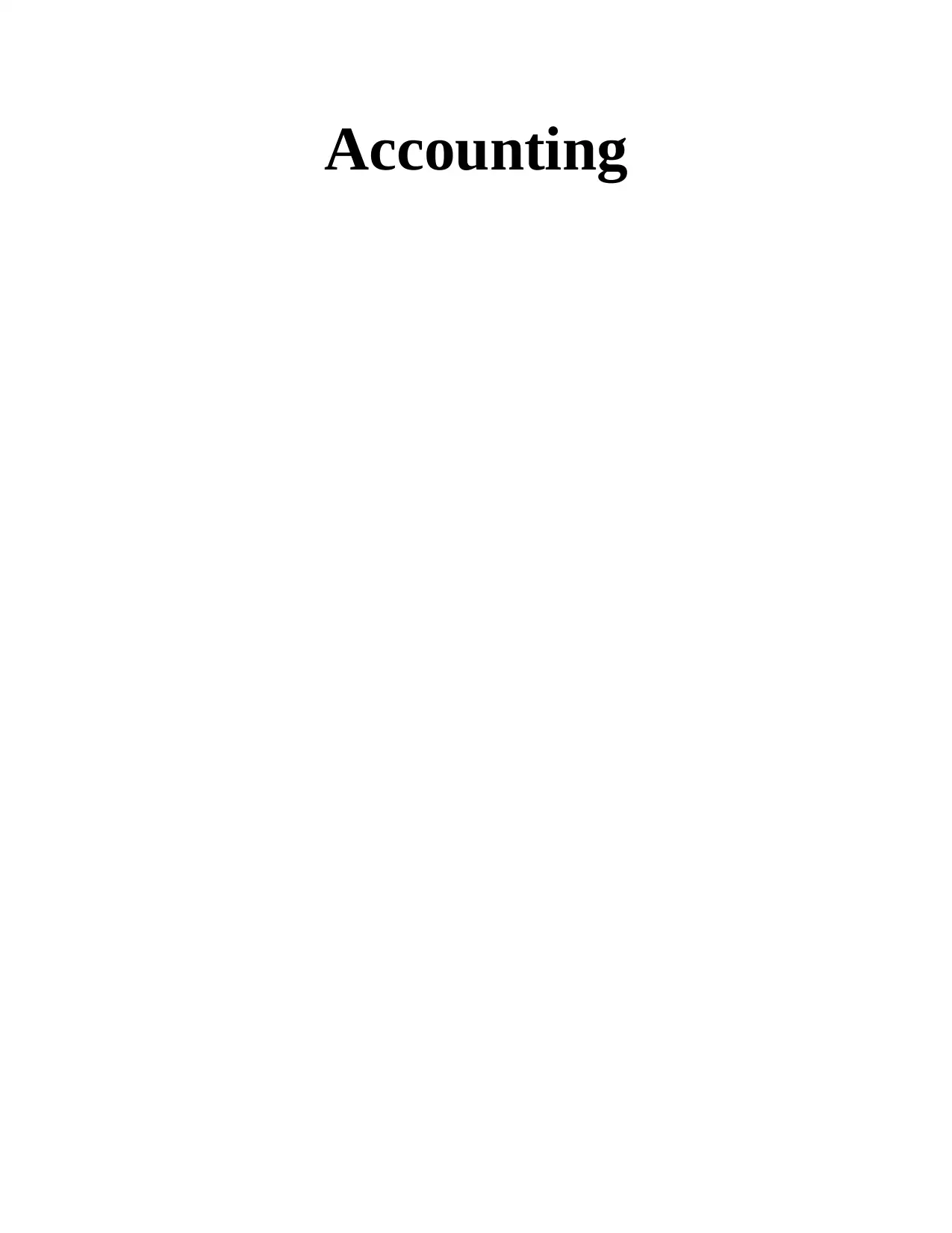
Accounting
Paraphrase This Document
Need a fresh take? Get an instant paraphrase of this document with our AI Paraphraser

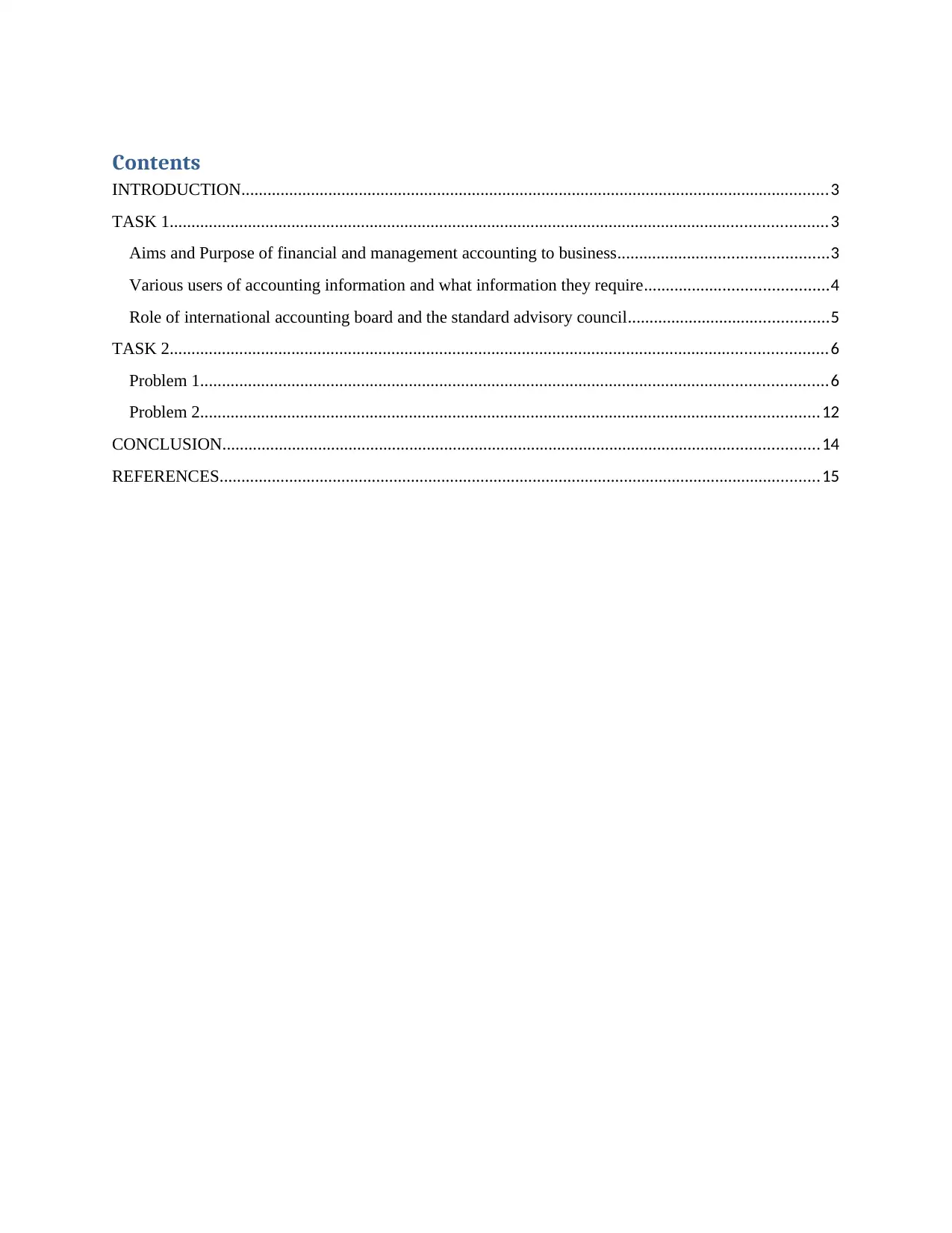
Contents
INTRODUCTION.......................................................................................................................................3
TASK 1.......................................................................................................................................................3
Aims and Purpose of financial and management accounting to business................................................3
Various users of accounting information and what information they require..........................................4
Role of international accounting board and the standard advisory council..............................................5
TASK 2.......................................................................................................................................................6
Problem 1................................................................................................................................................6
Problem 2..............................................................................................................................................12
CONCLUSION.........................................................................................................................................14
REFERENCES..........................................................................................................................................15
INTRODUCTION.......................................................................................................................................3
TASK 1.......................................................................................................................................................3
Aims and Purpose of financial and management accounting to business................................................3
Various users of accounting information and what information they require..........................................4
Role of international accounting board and the standard advisory council..............................................5
TASK 2.......................................................................................................................................................6
Problem 1................................................................................................................................................6
Problem 2..............................................................................................................................................12
CONCLUSION.........................................................................................................................................14
REFERENCES..........................................................................................................................................15
⊘ This is a preview!⊘
Do you want full access?
Subscribe today to unlock all pages.

Trusted by 1+ million students worldwide
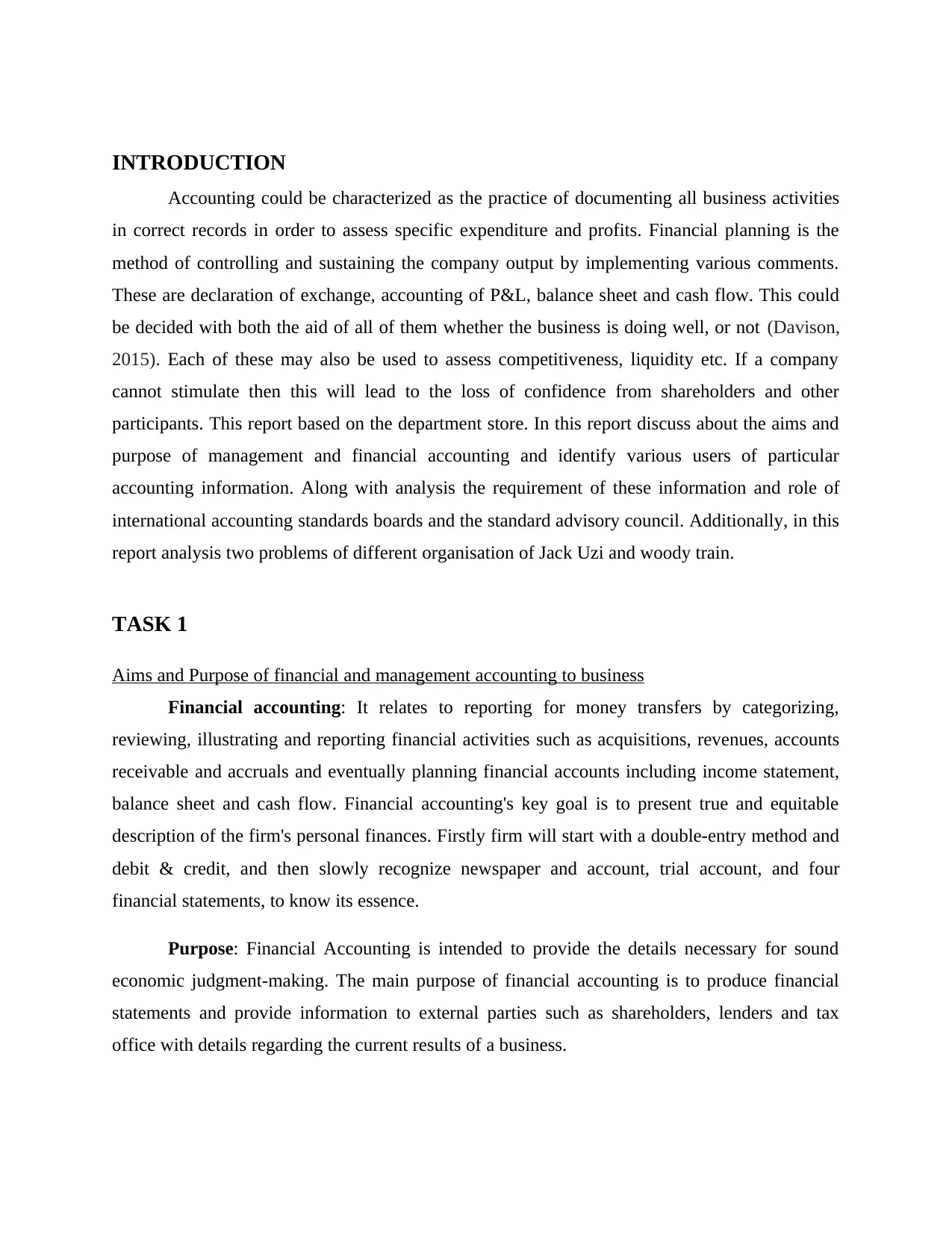
INTRODUCTION
Accounting could be characterized as the practice of documenting all business activities
in correct records in order to assess specific expenditure and profits. Financial planning is the
method of controlling and sustaining the company output by implementing various comments.
These are declaration of exchange, accounting of P&L, balance sheet and cash flow. This could
be decided with both the aid of all of them whether the business is doing well, or not (Davison,
2015). Each of these may also be used to assess competitiveness, liquidity etc. If a company
cannot stimulate then this will lead to the loss of confidence from shareholders and other
participants. This report based on the department store. In this report discuss about the aims and
purpose of management and financial accounting and identify various users of particular
accounting information. Along with analysis the requirement of these information and role of
international accounting standards boards and the standard advisory council. Additionally, in this
report analysis two problems of different organisation of Jack Uzi and woody train.
TASK 1
Aims and Purpose of financial and management accounting to business
Financial accounting: It relates to reporting for money transfers by categorizing,
reviewing, illustrating and reporting financial activities such as acquisitions, revenues, accounts
receivable and accruals and eventually planning financial accounts including income statement,
balance sheet and cash flow. Financial accounting's key goal is to present true and equitable
description of the firm's personal finances. Firstly firm will start with a double-entry method and
debit & credit, and then slowly recognize newspaper and account, trial account, and four
financial statements, to know its essence.
Purpose: Financial Accounting is intended to provide the details necessary for sound
economic judgment-making. The main purpose of financial accounting is to produce financial
statements and provide information to external parties such as shareholders, lenders and tax
office with details regarding the current results of a business.
Accounting could be characterized as the practice of documenting all business activities
in correct records in order to assess specific expenditure and profits. Financial planning is the
method of controlling and sustaining the company output by implementing various comments.
These are declaration of exchange, accounting of P&L, balance sheet and cash flow. This could
be decided with both the aid of all of them whether the business is doing well, or not (Davison,
2015). Each of these may also be used to assess competitiveness, liquidity etc. If a company
cannot stimulate then this will lead to the loss of confidence from shareholders and other
participants. This report based on the department store. In this report discuss about the aims and
purpose of management and financial accounting and identify various users of particular
accounting information. Along with analysis the requirement of these information and role of
international accounting standards boards and the standard advisory council. Additionally, in this
report analysis two problems of different organisation of Jack Uzi and woody train.
TASK 1
Aims and Purpose of financial and management accounting to business
Financial accounting: It relates to reporting for money transfers by categorizing,
reviewing, illustrating and reporting financial activities such as acquisitions, revenues, accounts
receivable and accruals and eventually planning financial accounts including income statement,
balance sheet and cash flow. Financial accounting's key goal is to present true and equitable
description of the firm's personal finances. Firstly firm will start with a double-entry method and
debit & credit, and then slowly recognize newspaper and account, trial account, and four
financial statements, to know its essence.
Purpose: Financial Accounting is intended to provide the details necessary for sound
economic judgment-making. The main purpose of financial accounting is to produce financial
statements and provide information to external parties such as shareholders, lenders and tax
office with details regarding the current results of a business.
Paraphrase This Document
Need a fresh take? Get an instant paraphrase of this document with our AI Paraphraser
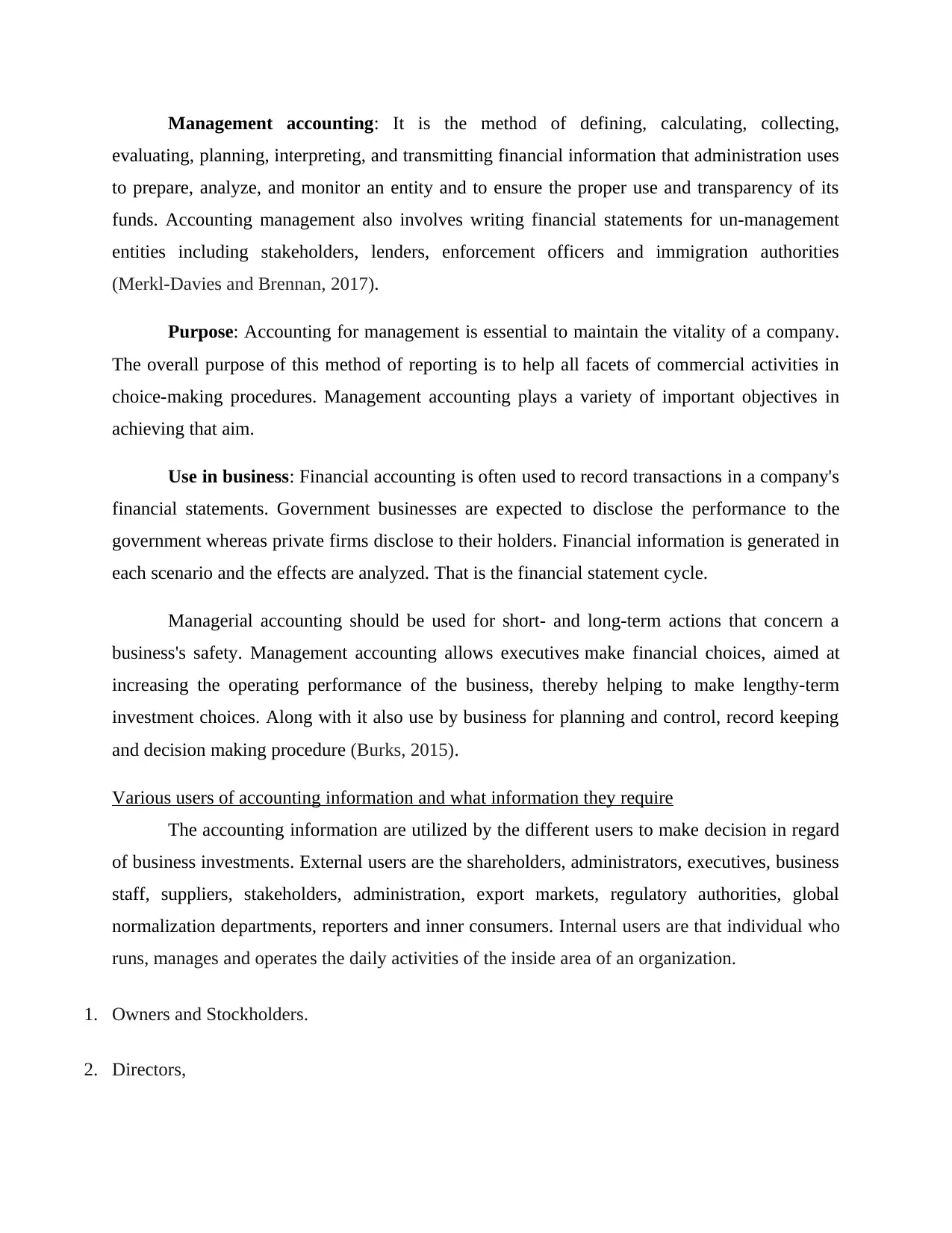
Management accounting: It is the method of defining, calculating, collecting,
evaluating, planning, interpreting, and transmitting financial information that administration uses
to prepare, analyze, and monitor an entity and to ensure the proper use and transparency of its
funds. Accounting management also involves writing financial statements for un-management
entities including stakeholders, lenders, enforcement officers and immigration authorities
(Merkl-Davies and Brennan, 2017).
Purpose: Accounting for management is essential to maintain the vitality of a company.
The overall purpose of this method of reporting is to help all facets of commercial activities in
choice-making procedures. Management accounting plays a variety of important objectives in
achieving that aim.
Use in business: Financial accounting is often used to record transactions in a company's
financial statements. Government businesses are expected to disclose the performance to the
government whereas private firms disclose to their holders. Financial information is generated in
each scenario and the effects are analyzed. That is the financial statement cycle.
Managerial accounting should be used for short- and long-term actions that concern a
business's safety. Management accounting allows executives make financial choices, aimed at
increasing the operating performance of the business, thereby helping to make lengthy-term
investment choices. Along with it also use by business for planning and control, record keeping
and decision making procedure (Burks, 2015).
Various users of accounting information and what information they require
The accounting information are utilized by the different users to make decision in regard
of business investments. External users are the shareholders, administrators, executives, business
staff, suppliers, stakeholders, administration, export markets, regulatory authorities, global
normalization departments, reporters and inner consumers. Internal users are that individual who
runs, manages and operates the daily activities of the inside area of an organization.
1. Owners and Stockholders.
2. Directors,
evaluating, planning, interpreting, and transmitting financial information that administration uses
to prepare, analyze, and monitor an entity and to ensure the proper use and transparency of its
funds. Accounting management also involves writing financial statements for un-management
entities including stakeholders, lenders, enforcement officers and immigration authorities
(Merkl-Davies and Brennan, 2017).
Purpose: Accounting for management is essential to maintain the vitality of a company.
The overall purpose of this method of reporting is to help all facets of commercial activities in
choice-making procedures. Management accounting plays a variety of important objectives in
achieving that aim.
Use in business: Financial accounting is often used to record transactions in a company's
financial statements. Government businesses are expected to disclose the performance to the
government whereas private firms disclose to their holders. Financial information is generated in
each scenario and the effects are analyzed. That is the financial statement cycle.
Managerial accounting should be used for short- and long-term actions that concern a
business's safety. Management accounting allows executives make financial choices, aimed at
increasing the operating performance of the business, thereby helping to make lengthy-term
investment choices. Along with it also use by business for planning and control, record keeping
and decision making procedure (Burks, 2015).
Various users of accounting information and what information they require
The accounting information are utilized by the different users to make decision in regard
of business investments. External users are the shareholders, administrators, executives, business
staff, suppliers, stakeholders, administration, export markets, regulatory authorities, global
normalization departments, reporters and inner consumers. Internal users are that individual who
runs, manages and operates the daily activities of the inside area of an organization.
1. Owners and Stockholders.
2. Directors,
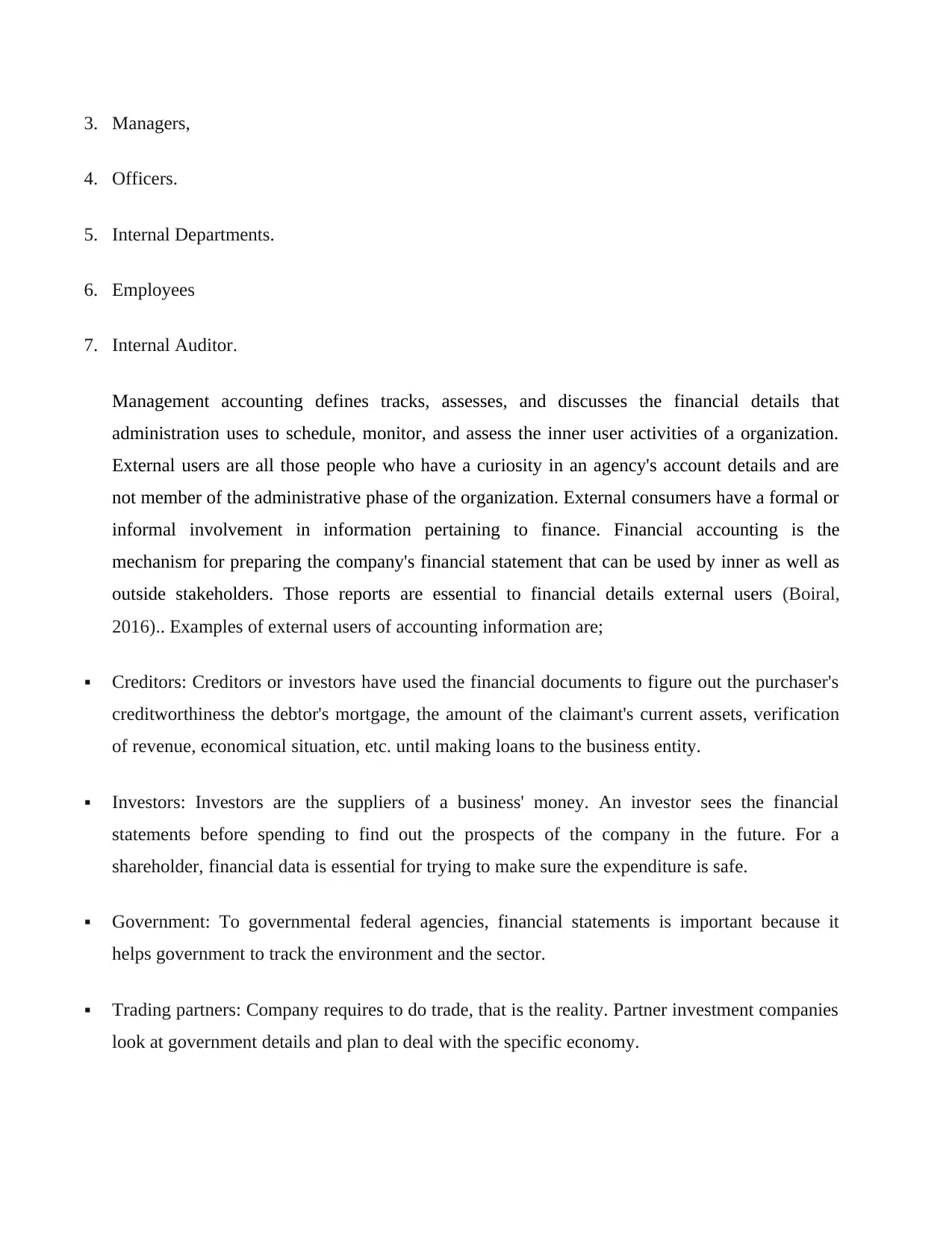
3. Managers,
4. Officers.
5. Internal Departments.
6. Employees
7. Internal Auditor.
Management accounting defines tracks, assesses, and discusses the financial details that
administration uses to schedule, monitor, and assess the inner user activities of a organization.
External users are all those people who have a curiosity in an agency's account details and are
not member of the administrative phase of the organization. External consumers have a formal or
informal involvement in information pertaining to finance. Financial accounting is the
mechanism for preparing the company's financial statement that can be used by inner as well as
outside stakeholders. Those reports are essential to financial details external users (Boiral,
2016).. Examples of external users of accounting information are;
Creditors: Creditors or investors have used the financial documents to figure out the purchaser's
creditworthiness the debtor's mortgage, the amount of the claimant's current assets, verification
of revenue, economical situation, etc. until making loans to the business entity.
Investors: Investors are the suppliers of a business' money. An investor sees the financial
statements before spending to find out the prospects of the company in the future. For a
shareholder, financial data is essential for trying to make sure the expenditure is safe.
Government: To governmental federal agencies, financial statements is important because it
helps government to track the environment and the sector.
Trading partners: Company requires to do trade, that is the reality. Partner investment companies
look at government details and plan to deal with the specific economy.
4. Officers.
5. Internal Departments.
6. Employees
7. Internal Auditor.
Management accounting defines tracks, assesses, and discusses the financial details that
administration uses to schedule, monitor, and assess the inner user activities of a organization.
External users are all those people who have a curiosity in an agency's account details and are
not member of the administrative phase of the organization. External consumers have a formal or
informal involvement in information pertaining to finance. Financial accounting is the
mechanism for preparing the company's financial statement that can be used by inner as well as
outside stakeholders. Those reports are essential to financial details external users (Boiral,
2016).. Examples of external users of accounting information are;
Creditors: Creditors or investors have used the financial documents to figure out the purchaser's
creditworthiness the debtor's mortgage, the amount of the claimant's current assets, verification
of revenue, economical situation, etc. until making loans to the business entity.
Investors: Investors are the suppliers of a business' money. An investor sees the financial
statements before spending to find out the prospects of the company in the future. For a
shareholder, financial data is essential for trying to make sure the expenditure is safe.
Government: To governmental federal agencies, financial statements is important because it
helps government to track the environment and the sector.
Trading partners: Company requires to do trade, that is the reality. Partner investment companies
look at government details and plan to deal with the specific economy.
⊘ This is a preview!⊘
Do you want full access?
Subscribe today to unlock all pages.

Trusted by 1+ million students worldwide
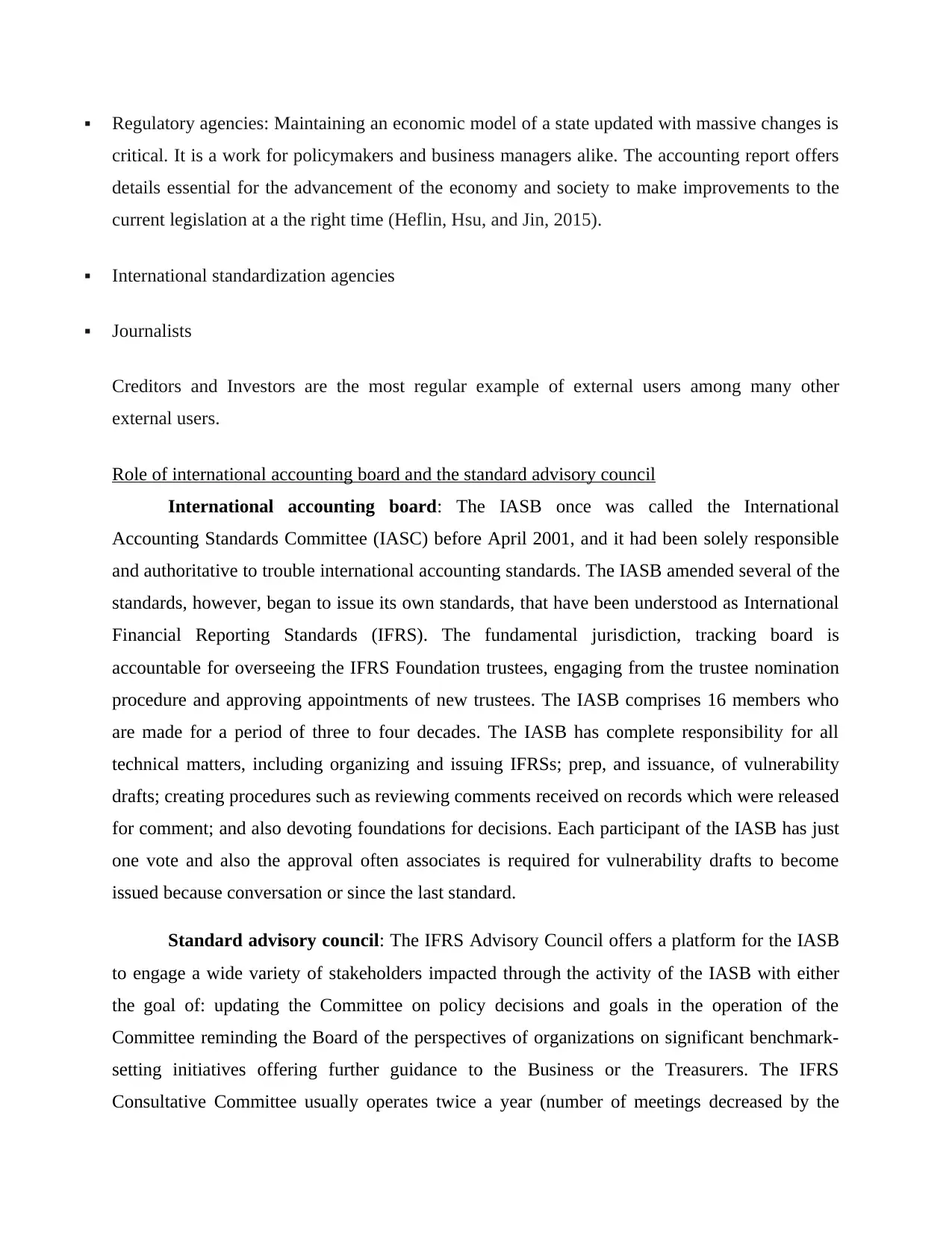
Regulatory agencies: Maintaining an economic model of a state updated with massive changes is
critical. It is a work for policymakers and business managers alike. The accounting report offers
details essential for the advancement of the economy and society to make improvements to the
current legislation at a the right time (Heflin, Hsu, and Jin, 2015).
International standardization agencies
Journalists
Creditors and Investors are the most regular example of external users among many other
external users.
Role of international accounting board and the standard advisory council
International accounting board: The IASB once was called the International
Accounting Standards Committee (IASC) before April 2001, and it had been solely responsible
and authoritative to trouble international accounting standards. The IASB amended several of the
standards, however, began to issue its own standards, that have been understood as International
Financial Reporting Standards (IFRS). The fundamental jurisdiction, tracking board is
accountable for overseeing the IFRS Foundation trustees, engaging from the trustee nomination
procedure and approving appointments of new trustees. The IASB comprises 16 members who
are made for a period of three to four decades. The IASB has complete responsibility for all
technical matters, including organizing and issuing IFRSs; prep, and issuance, of vulnerability
drafts; creating procedures such as reviewing comments received on records which were released
for comment; and also devoting foundations for decisions. Each participant of the IASB has just
one vote and also the approval often associates is required for vulnerability drafts to become
issued because conversation or since the last standard.
Standard advisory council: The IFRS Advisory Council offers a platform for the IASB
to engage a wide variety of stakeholders impacted through the activity of the IASB with either
the goal of: updating the Committee on policy decisions and goals in the operation of the
Committee reminding the Board of the perspectives of organizations on significant benchmark-
setting initiatives offering further guidance to the Business or the Treasurers. The IFRS
Consultative Committee usually operates twice a year (number of meetings decreased by the
critical. It is a work for policymakers and business managers alike. The accounting report offers
details essential for the advancement of the economy and society to make improvements to the
current legislation at a the right time (Heflin, Hsu, and Jin, 2015).
International standardization agencies
Journalists
Creditors and Investors are the most regular example of external users among many other
external users.
Role of international accounting board and the standard advisory council
International accounting board: The IASB once was called the International
Accounting Standards Committee (IASC) before April 2001, and it had been solely responsible
and authoritative to trouble international accounting standards. The IASB amended several of the
standards, however, began to issue its own standards, that have been understood as International
Financial Reporting Standards (IFRS). The fundamental jurisdiction, tracking board is
accountable for overseeing the IFRS Foundation trustees, engaging from the trustee nomination
procedure and approving appointments of new trustees. The IASB comprises 16 members who
are made for a period of three to four decades. The IASB has complete responsibility for all
technical matters, including organizing and issuing IFRSs; prep, and issuance, of vulnerability
drafts; creating procedures such as reviewing comments received on records which were released
for comment; and also devoting foundations for decisions. Each participant of the IASB has just
one vote and also the approval often associates is required for vulnerability drafts to become
issued because conversation or since the last standard.
Standard advisory council: The IFRS Advisory Council offers a platform for the IASB
to engage a wide variety of stakeholders impacted through the activity of the IASB with either
the goal of: updating the Committee on policy decisions and goals in the operation of the
Committee reminding the Board of the perspectives of organizations on significant benchmark-
setting initiatives offering further guidance to the Business or the Treasurers. The IFRS
Consultative Committee usually operates twice a year (number of meetings decreased by the
Paraphrase This Document
Need a fresh take? Get an instant paraphrase of this document with our AI Paraphraser
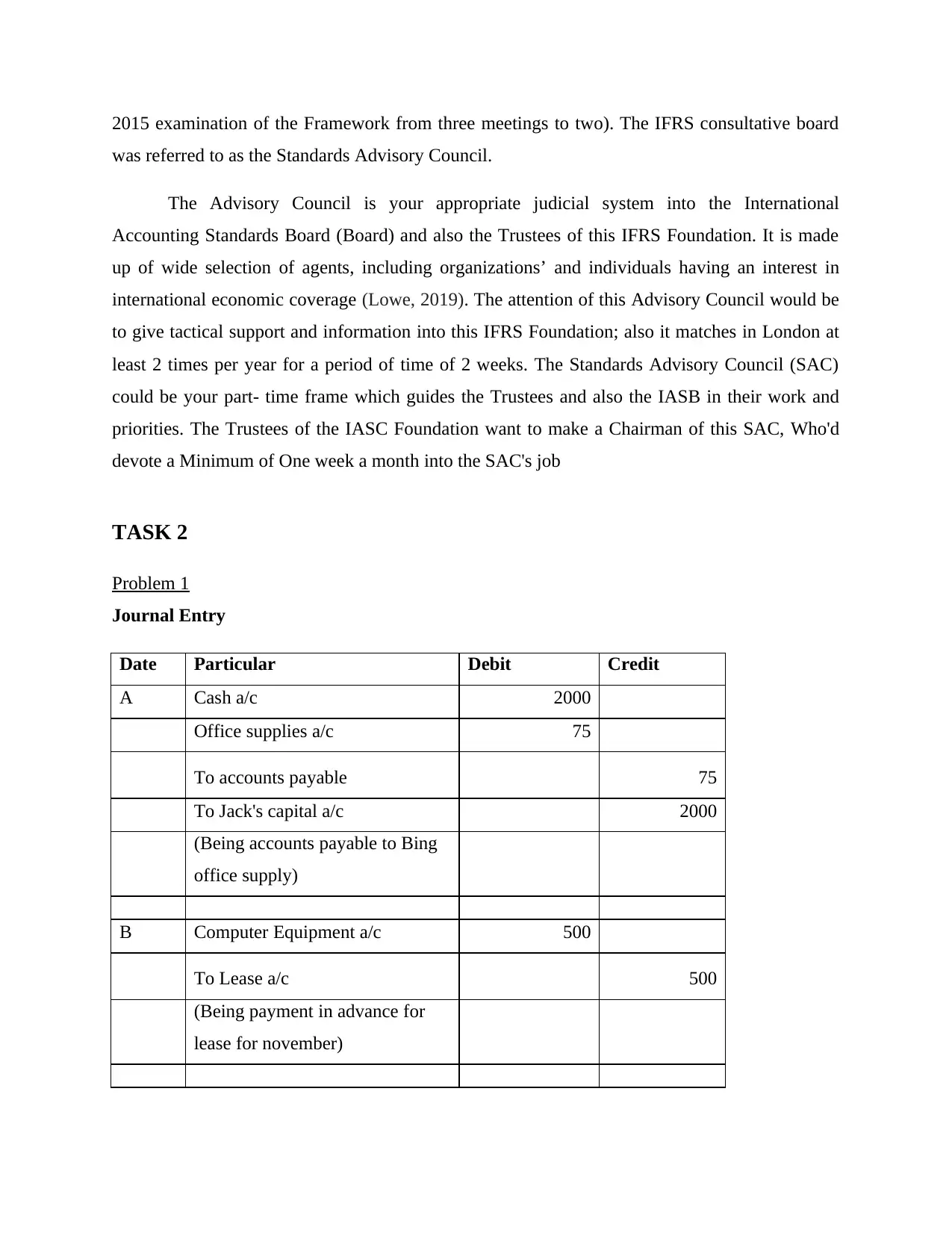
2015 examination of the Framework from three meetings to two). The IFRS consultative board
was referred to as the Standards Advisory Council.
The Advisory Council is your appropriate judicial system into the International
Accounting Standards Board (Board) and also the Trustees of this IFRS Foundation. It is made
up of wide selection of agents, including organizations’ and individuals having an interest in
international economic coverage (Lowe, 2019). The attention of this Advisory Council would be
to give tactical support and information into this IFRS Foundation; also it matches in London at
least 2 times per year for a period of time of 2 weeks. The Standards Advisory Council (SAC)
could be your part- time frame which guides the Trustees and also the IASB in their work and
priorities. The Trustees of the IASC Foundation want to make a Chairman of this SAC, Who'd
devote a Minimum of One week a month into the SAC's job
TASK 2
Problem 1
Journal Entry
Date Particular Debit Credit
A Cash a/c 2000
Office supplies a/c 75
To accounts payable 75
To Jack's capital a/c 2000
(Being accounts payable to Bing
office supply)
B Computer Equipment a/c 500
To Lease a/c 500
(Being payment in advance for
lease for november)
was referred to as the Standards Advisory Council.
The Advisory Council is your appropriate judicial system into the International
Accounting Standards Board (Board) and also the Trustees of this IFRS Foundation. It is made
up of wide selection of agents, including organizations’ and individuals having an interest in
international economic coverage (Lowe, 2019). The attention of this Advisory Council would be
to give tactical support and information into this IFRS Foundation; also it matches in London at
least 2 times per year for a period of time of 2 weeks. The Standards Advisory Council (SAC)
could be your part- time frame which guides the Trustees and also the IASB in their work and
priorities. The Trustees of the IASC Foundation want to make a Chairman of this SAC, Who'd
devote a Minimum of One week a month into the SAC's job
TASK 2
Problem 1
Journal Entry
Date Particular Debit Credit
A Cash a/c 2000
Office supplies a/c 75
To accounts payable 75
To Jack's capital a/c 2000
(Being accounts payable to Bing
office supply)
B Computer Equipment a/c 500
To Lease a/c 500
(Being payment in advance for
lease for november)
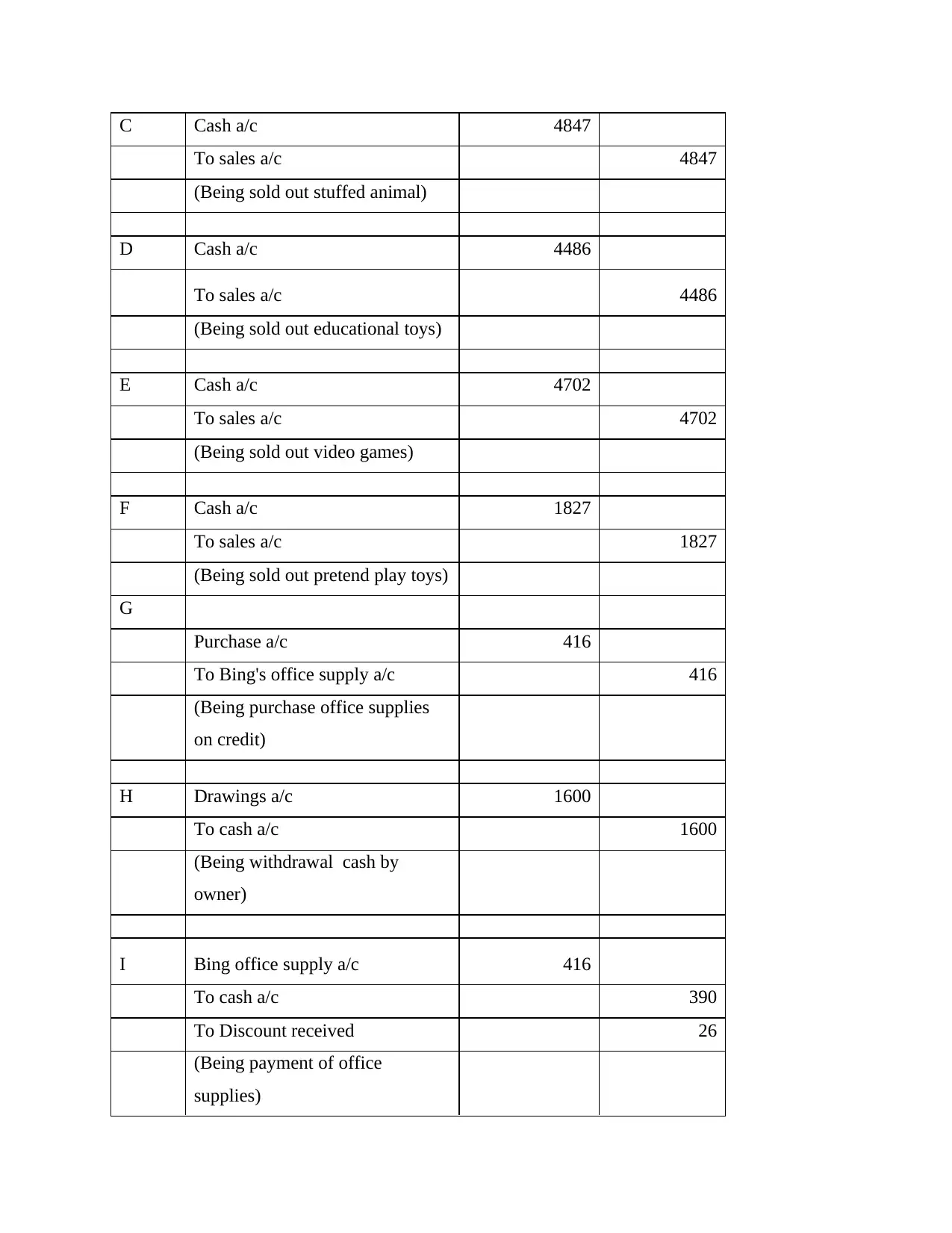
C Cash a/c 4847
To sales a/c 4847
(Being sold out stuffed animal)
D Cash a/c 4486
To sales a/c 4486
(Being sold out educational toys)
E Cash a/c 4702
To sales a/c 4702
(Being sold out video games)
F Cash a/c 1827
To sales a/c 1827
(Being sold out pretend play toys)
G
Purchase a/c 416
To Bing's office supply a/c 416
(Being purchase office supplies
on credit)
H Drawings a/c 1600
To cash a/c 1600
(Being withdrawal cash by
owner)
I Bing office supply a/c 416
To cash a/c 390
To Discount received 26
(Being payment of office
supplies)
To sales a/c 4847
(Being sold out stuffed animal)
D Cash a/c 4486
To sales a/c 4486
(Being sold out educational toys)
E Cash a/c 4702
To sales a/c 4702
(Being sold out video games)
F Cash a/c 1827
To sales a/c 1827
(Being sold out pretend play toys)
G
Purchase a/c 416
To Bing's office supply a/c 416
(Being purchase office supplies
on credit)
H Drawings a/c 1600
To cash a/c 1600
(Being withdrawal cash by
owner)
I Bing office supply a/c 416
To cash a/c 390
To Discount received 26
(Being payment of office
supplies)
⊘ This is a preview!⊘
Do you want full access?
Subscribe today to unlock all pages.

Trusted by 1+ million students worldwide
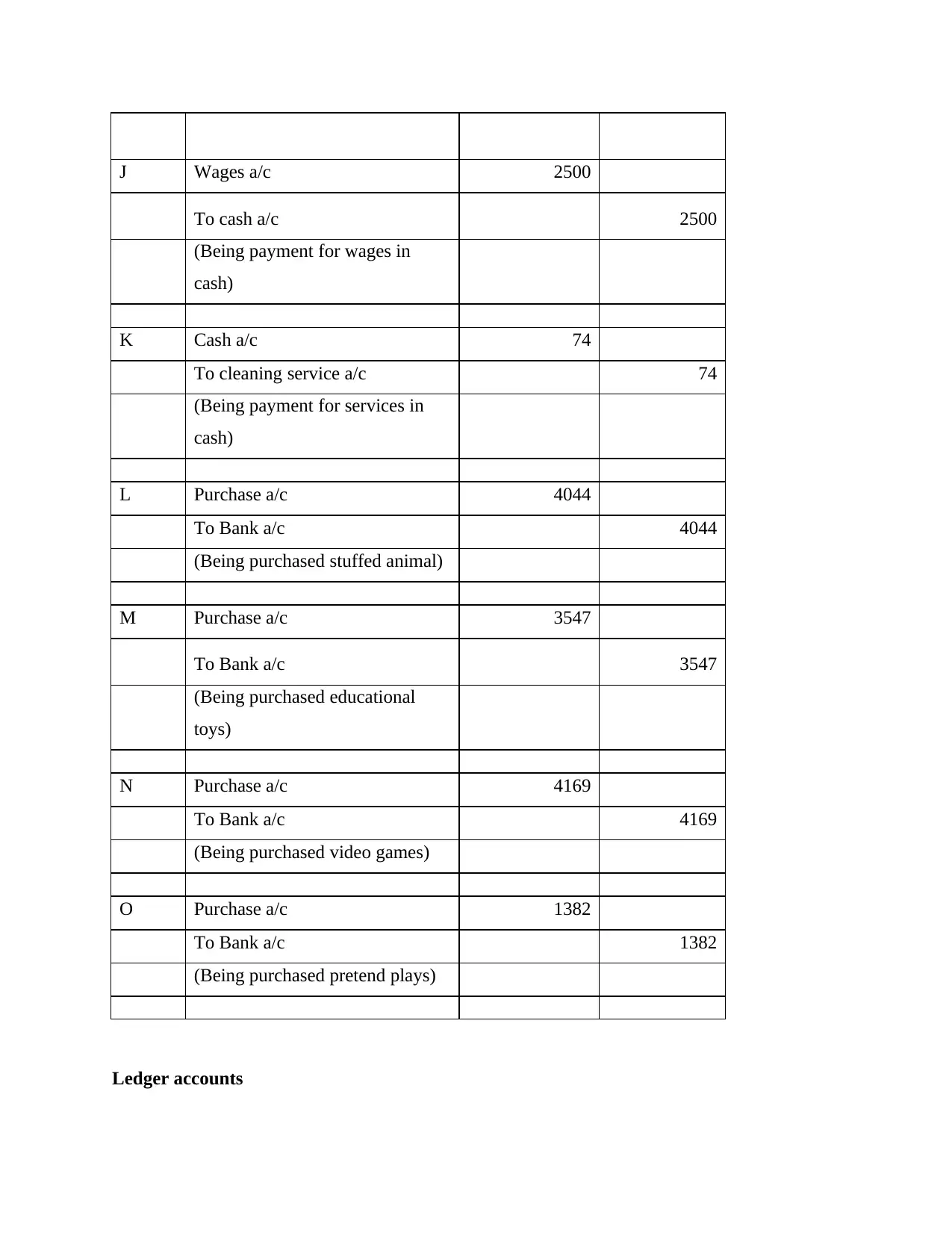
J Wages a/c 2500
To cash a/c 2500
(Being payment for wages in
cash)
K Cash a/c 74
To cleaning service a/c 74
(Being payment for services in
cash)
L Purchase a/c 4044
To Bank a/c 4044
(Being purchased stuffed animal)
M Purchase a/c 3547
To Bank a/c 3547
(Being purchased educational
toys)
N Purchase a/c 4169
To Bank a/c 4169
(Being purchased video games)
O Purchase a/c 1382
To Bank a/c 1382
(Being purchased pretend plays)
Ledger accounts
To cash a/c 2500
(Being payment for wages in
cash)
K Cash a/c 74
To cleaning service a/c 74
(Being payment for services in
cash)
L Purchase a/c 4044
To Bank a/c 4044
(Being purchased stuffed animal)
M Purchase a/c 3547
To Bank a/c 3547
(Being purchased educational
toys)
N Purchase a/c 4169
To Bank a/c 4169
(Being purchased video games)
O Purchase a/c 1382
To Bank a/c 1382
(Being purchased pretend plays)
Ledger accounts
Paraphrase This Document
Need a fresh take? Get an instant paraphrase of this document with our AI Paraphraser

Cash a/c
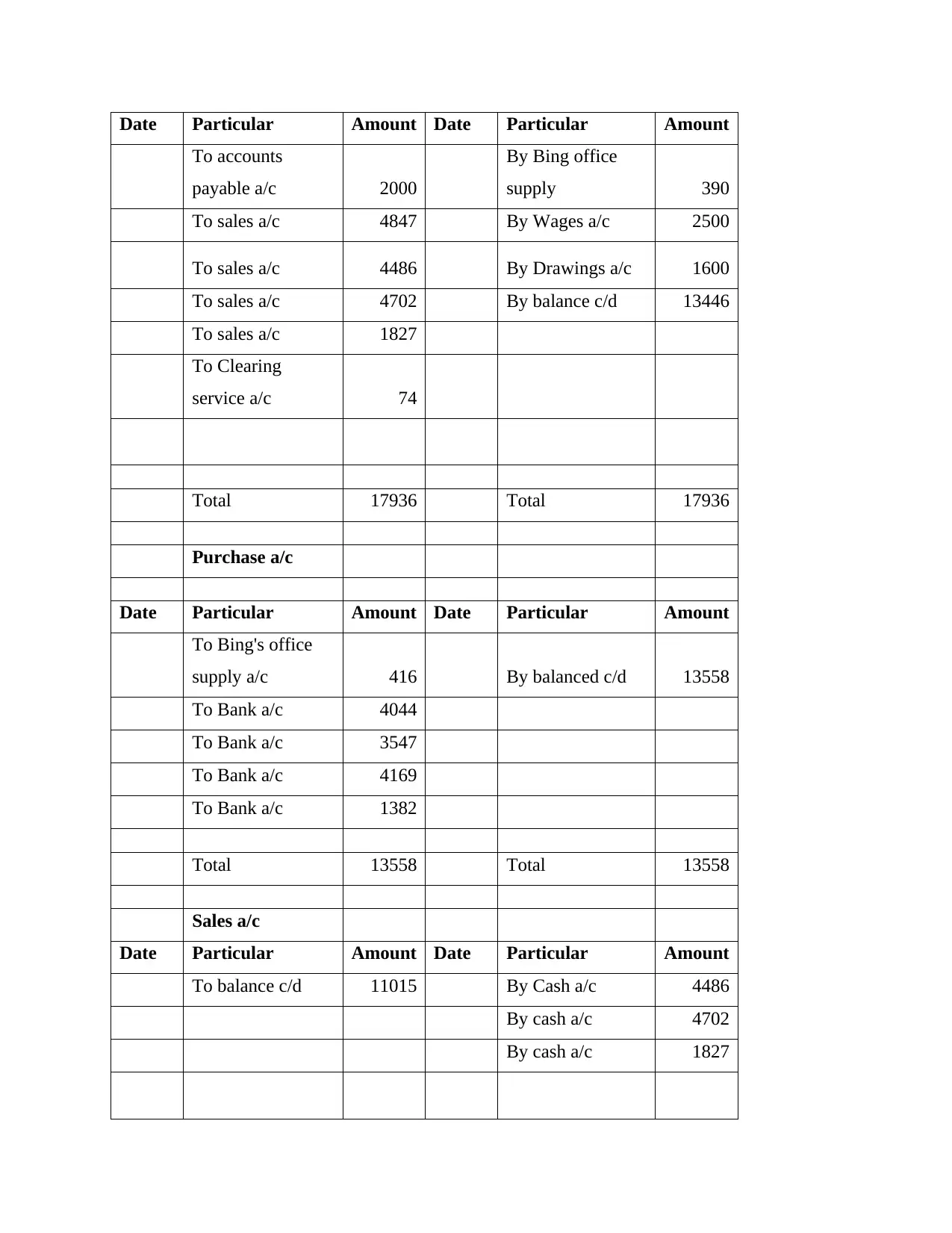
Date Particular Amount Date Particular Amount
To accounts
payable a/c 2000
By Bing office
supply 390
To sales a/c 4847 By Wages a/c 2500
To sales a/c 4486 By Drawings a/c 1600
To sales a/c 4702 By balance c/d 13446
To sales a/c 1827
To Clearing
service a/c 74
Total 17936 Total 17936
Purchase a/c
Date Particular Amount Date Particular Amount
To Bing's office
supply a/c 416 By balanced c/d 13558
To Bank a/c 4044
To Bank a/c 3547
To Bank a/c 4169
To Bank a/c 1382
Total 13558 Total 13558
Sales a/c
Date Particular Amount Date Particular Amount
To balance c/d 11015 By Cash a/c 4486
By cash a/c 4702
By cash a/c 1827
To accounts
payable a/c 2000
By Bing office
supply 390
To sales a/c 4847 By Wages a/c 2500
To sales a/c 4486 By Drawings a/c 1600
To sales a/c 4702 By balance c/d 13446
To sales a/c 1827
To Clearing
service a/c 74
Total 17936 Total 17936
Purchase a/c
Date Particular Amount Date Particular Amount
To Bing's office
supply a/c 416 By balanced c/d 13558
To Bank a/c 4044
To Bank a/c 3547
To Bank a/c 4169
To Bank a/c 1382
Total 13558 Total 13558
Sales a/c
Date Particular Amount Date Particular Amount
To balance c/d 11015 By Cash a/c 4486
By cash a/c 4702
By cash a/c 1827
⊘ This is a preview!⊘
Do you want full access?
Subscribe today to unlock all pages.

Trusted by 1+ million students worldwide
1 out of 20
Related Documents
Your All-in-One AI-Powered Toolkit for Academic Success.
+13062052269
info@desklib.com
Available 24*7 on WhatsApp / Email
![[object Object]](/_next/static/media/star-bottom.7253800d.svg)
Unlock your academic potential
Copyright © 2020–2025 A2Z Services. All Rights Reserved. Developed and managed by ZUCOL.




